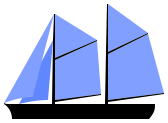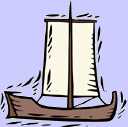


 R Home Glossary T
R Home Glossary T
Revised May 27 2021
Although the form of sails is extremely different, they are all nevertheless triangular or quadrilateral figures; or, in other words, their surfaces are contained either between three or four sides. The former of these are sometimes spread by a yard, as lateen sails; and otherwise by a stay, as staysails; or by a mast, as shoulder-of-mutton sails; in all which cases the foremost leech or edge is attached to the said yard, mast, or stay, throughout its whole length. The latter, or those which are four-sided, are either extended by yards, as the principal sails of a ship; or by yards and booms, as the studding sails, drivers, ringtails, and all those sails which are set occasionally; or by gaffs and booms, as the mainsails of sloops and brigantines. The principal sails of a ship are the courses or lower sails, the topsails, which are next in order above the courses; and the topgallant sails, which are expanded above the topsails.
The courses are the mainsail, foresail, and mizen, main staysail, fore staysail and mizen staysail; but more particularly the three first.
N.B. The main staysail is rarely used except in small vessels.
In all quadrangular sails the upper edge is called the
head; the sides or skirts are called
leeches; and the bottom or lower edge is termed the
foot. If the head is parallel to the foot, the two lower corners are denominated
clues, and the upper corners
earings. In all triangular sails, and in those four-sided sails
wherein the head is not parallel to the foot, the foremost corner at the foot is called the
tack; and the
after lower corner the clue; the foremost perpendicular or sloping edge is called the fore leech, and the
hindmost the after leech. The heads of all four-sided sails, and the fore-leeches of lateen sails, are
attached to their respective yard or gaff by a number of small cords called
robands; and the extremities are tied to the
yardarms, or to the
peek of the gaff, by earings. The staysails are extended upon stays
between the masts, whereon they are drawn up or down occasionally, as a curtain slides upon its rod, and
their lower parts are stretched out by a tack and
sheet. The clues of a topsail are drawn out to the
extremities of the lower yard, by two large ropes called the topsail sheets; and the clues of the
topgallant sails are in like manner extended upon the topsail yardarms.
make sail
set sail
shorten sail
The principal regulations with regard to salutes in the royal navy are as follow:
"When a flag officer salutes the admiral and commander in chief of the fleet, he is to give him fifteen guns; but when captains salute him, they are to give him, seventeen guns. The admiral or commander in chief of the fleet is to return two guns less to flag officers, and four less to captains. Flag officers saluting their superior or senior officer, are to give him thirteen guns. Flag officers are to return an equal number of guns to flag officers bearing their flags on the same mast, and two guns less to the rest, as also to captains.
"When a captain salutes an admiral of the white or blue, he is to give him fifteen guns; but to vice and rear admirals, thirteen guns. When a flag officer is saluted by two or more of his Majesty's ships, he is not to return the salute till all have finished, and then to do it with such a reasonable number of guns as he shall judge proper.
"In case of the meeting of two squadrons, the two chiefs only are to exchange salutes. And if single ships meet a squadron consisting of more than one flag, the principal flag only is to be saluted. No salutes shall be repeated by the same ships, unless there has been a separation of six months at least.
"None of his Majesty's ships of war, commanded only by captains, shall give or receive salutes from one another, in whatsoever part of the world they meet.
"A flag officer commanding in chief shall be saluted, upon his first hoisting his flag, by all the ships present, with such a number of guns as is allowed by the first, third, or fifth articles."


The deep sea lead is marked with two knots at 20 fathom, 3 at 30, 4 at 40, and so on to the end. It is also marked with a single knot in the middle of each interval, as at 25, 35, 45 fathoms, &c. To use this lead more effectually at sea, or in deep water on the sea coast, it is usual previously to bring to the ship, in order to retard her course; the lead is then thrown as far as possible from the ship on the line of her drift, so that, as it sinks, the ship drives more perpendicularly over it. The pilot, feeling the lead strike the bottom, readily discovers the depth of the water by the mark on the line nearest its surface. The bottom of the lead being also well rubbed over with tallow, retains the distinguishing marks of the bottom, as shells, ooze, gravel, &c. which naturally adhere to it. The depth of the water, and the nature of the ground, which is called the soundings, are carefully marked in the logbook, as well to determine the distance of the place from the shore, as to correct the observations of former pilots.

"The first step in wort production is to make malt from dried, sprouted barley. Grain adjuncts are then added and the malt is ground into grist. The grist is mashed, that is, mixed with hot water and steeped, a complex and slow heating process that enables enzymes to convert the starch in the malt into sugars."
As best I understand it, at this point drain the liquid off and you have sweet wort.
 R Home Glossary T
R Home Glossary T